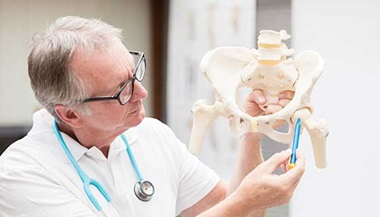Enchondroma
What is an enchondroma?
An enchondroma is a type of noncancerous bone tumor that begins in cartilage. Cartilage is the gristly connective tissue from which most bones develop. Cartilage plays an important role in the growth process. There are many different types of cartilage in the body. An enchondroma most often affects the cartilage that lines the inside of the bones. It often affects the tiny long bones of the hands and feet. It may also affect other bones such as the thighbone (femur), upper arm bone (humerus), or one of the two lower leg bones (tibia).
An enchondroma may happen as one or several tumors. The health conditions that involve multiple tumors include the following:
- Ollier disease. When multiple sites in the body develop the tumors.
- Maffucci syndrome. A combination of multiple tumors and angiomas (benign tumors made up of blood vessels).
Enchondromas are the most common type of hand tumor. While it may affect a person at any age, it is most common between ages 10 and 20. It affects men and women equally.
What causes an enchondroma?
The exact cause of enchondroma is not known. However, it is thought to happen due to either of the following:
- Overgrowth of the cartilage that lines the ends of the bones
- Persistent growth of original, embryonic cartilage
What are the symptoms of an enchondroma?
With an enchondroma, you may have no symptoms at all. The following are the most common symptoms of an enchondroma. However, each person may experience symptoms differently. Symptoms may include:
- Hand pain, if the tumor is very large or if the affected bone has weakened and caused a hand fracture
- Enlargement of the affected finger
- Slow bone growth in the affected area
The symptoms of enchondroma may look like other medical problems. Always talk with your healthcare provider for a diagnosis.
How is an enchondroma diagnosed?
Diagnosis is sometimes made during a routine physical exam or if the tumor leads to a fracture in the hand.
In addition to a complete medical history and physical exam, tests may include:
- X-rays. A test that uses invisible electromagnetic energy beams to produce images of internal tissues, bones, and organs on film.
- Radionuclide bone scans. A nuclear imaging test to evaluate any degenerative and/or arthritic changes in the joints, find bone diseases and tumors, and determine the cause of bone pain or inflammation. This test helps to rule out any infection or fractures.
- MRI. This test uses a combination of large magnets, radiofrequencies, and a computer to produce detailed images of organs and structures within the body. This test is done to rule out any associated abnormalities of the spinal cord and nerves.
- CT scan. An imaging test that uses a combination of X-rays and computer technology to produce horizontal images or slices of the body. A CT scan shows detailed images of any part of the body, including the bones, muscles, fat, and organs. CT scans are more detailed than general X-rays.
How is an enchondroma treated?
Specific treatment for enchondroma will be decided by your healthcare provider based on:
- Your age, overall health, and medical history
- Extent of the disease
- Your tolerance for specific medications, procedures, or therapies
- Expectations for the course of the disease
- Your opinion or preference
Treatment may include:
- Surgery. In some cases, surgery is done when bone weakening is present or fractures occur.
- Bone grafting. A surgical procedure in which healthy bone is transplanted from another part of the body into the affected area.
If there is no sign of bone weakening or growth of the tumor, your healthcare provider may simply keep close watch on your condition. However, follow-up with repeat X-rays may be needed. Some types of enchondromas can develop into cancerous bone tumors later. Careful follow-up with your healthcare provider is often recommended.
Key points about enchondromas
An enchondroma is a type of benign bone tumor that originates from cartilage. It is not cancerous. It most often affects the cartilage that lines the inside of the bones.
- Enchondromas are the most common type of hand tumor.
- The exact cause of enchondroma is not known.
- It is most common between ages 10 and 20.
- It affects women and men equally.
- You may have no symptoms at all.
- Diagnosis is sometimes made during a routine physical exam or if the presence of the tumor leads to a fracture in the hand.
- Treatment may include surgery, bone grafting, or watchful waiting.
Next steps
Tips to help you get the most from a visit to your healthcare provider:
- Know the reason for your visit and what you want to happen.
- Before your visit, write down questions you want answered.
- Bring someone with you to help you ask questions and remember what your provider tells you.
- At the visit, write down the name of a new diagnosis, and any new medicines, treatments, or tests. Also write down any new instructions your provider gives you.
- Know why a new medicine or treatment is prescribed, and how it will help you. Also know what the side effects are.
- Ask if your condition can be treated in other ways.
- Know why a test or procedure is recommended and what the results could mean.
- Know what to expect if you do not take the medicine or have the test or procedure.
- If you have a follow-up appointment, write down the date, time, and purpose for that visit.
- Know how you can contact your provider if you have questions.





